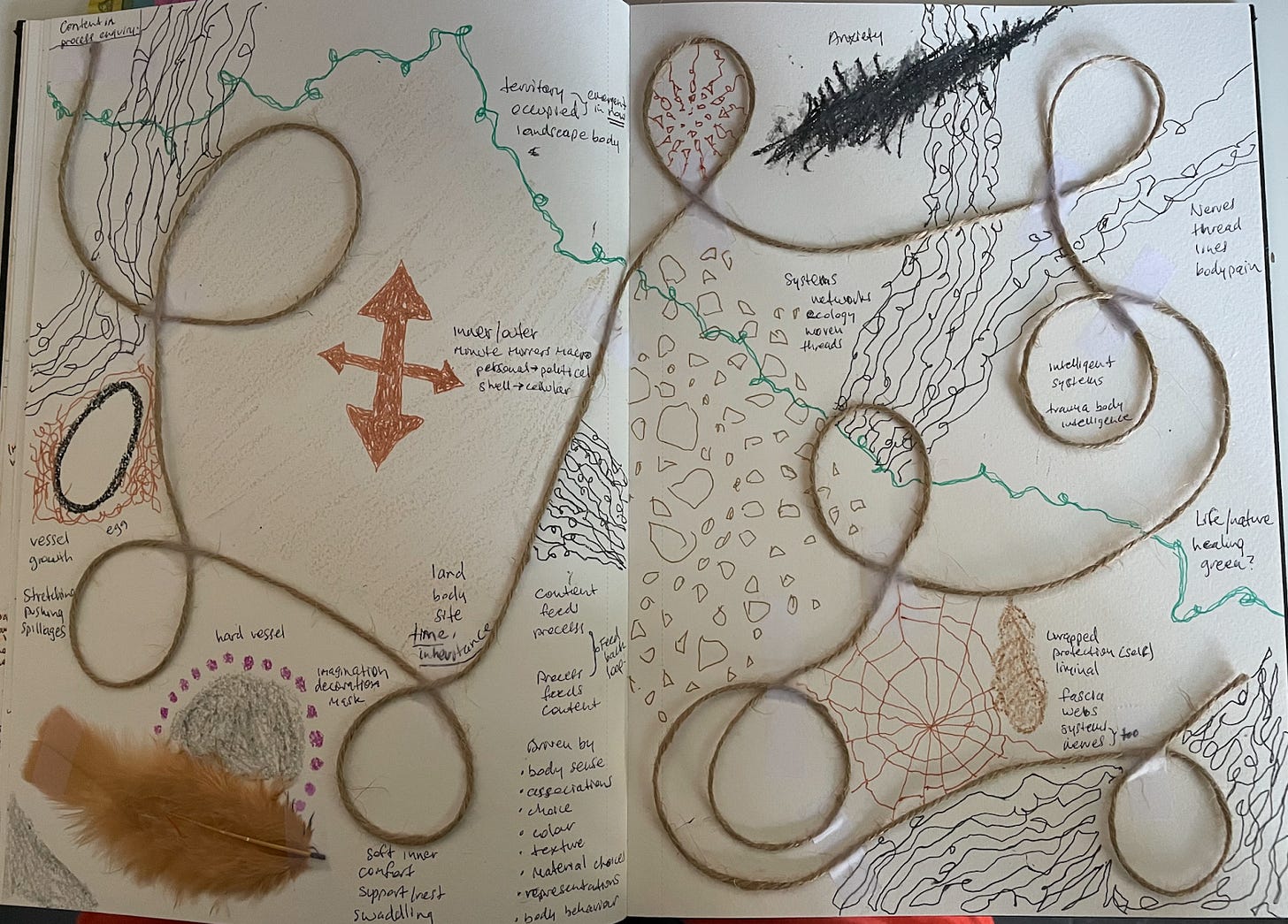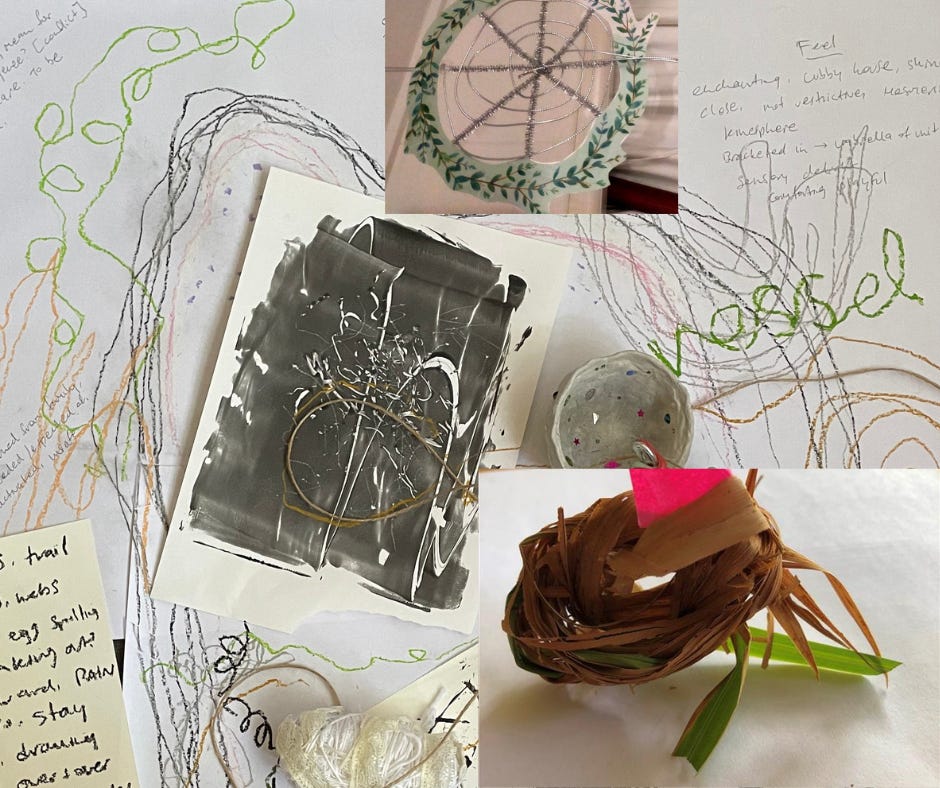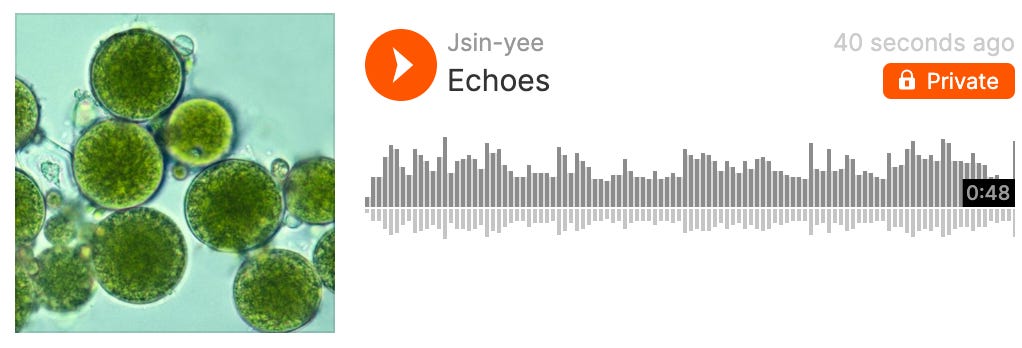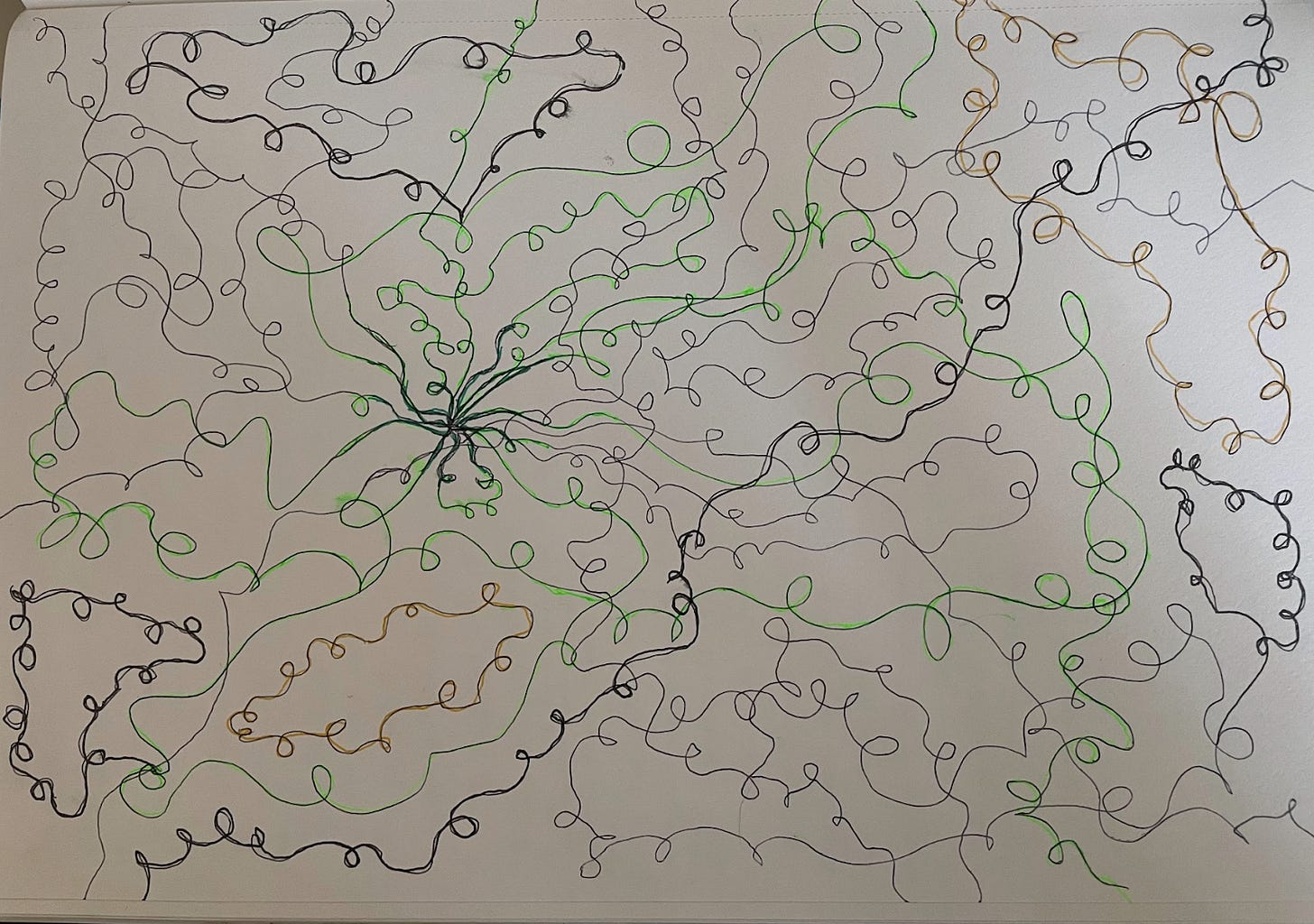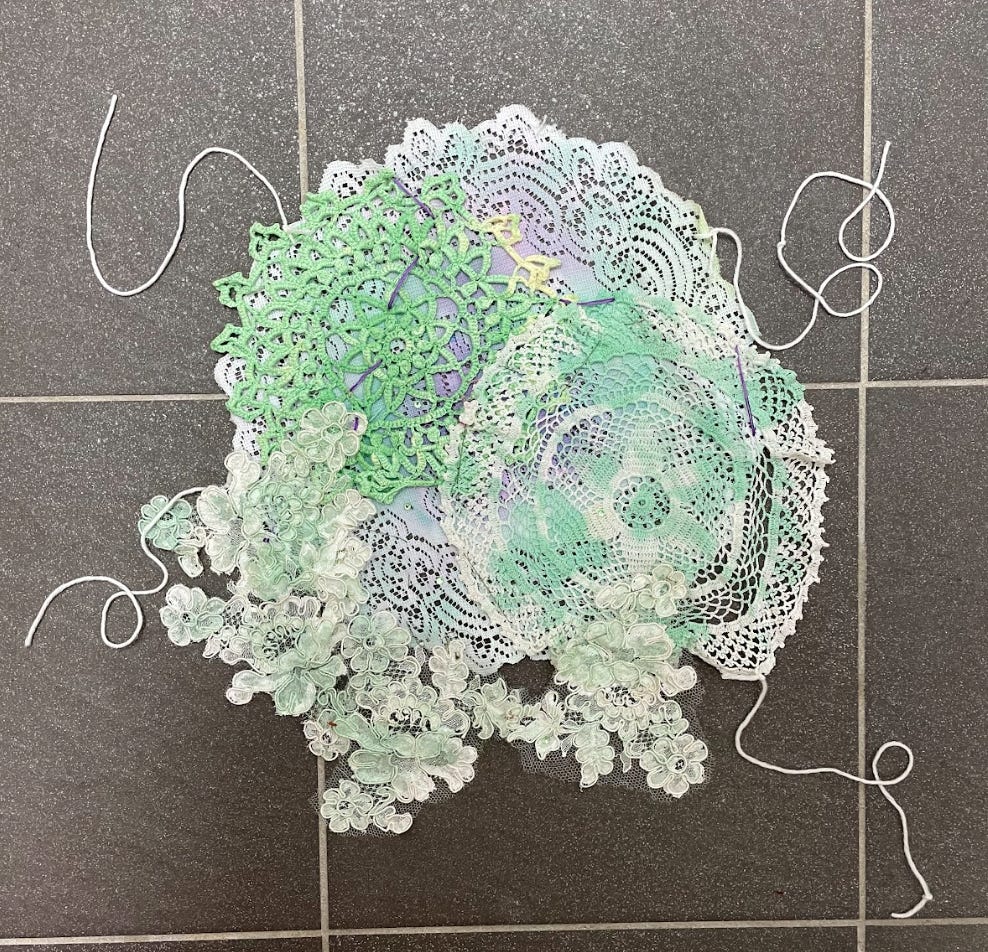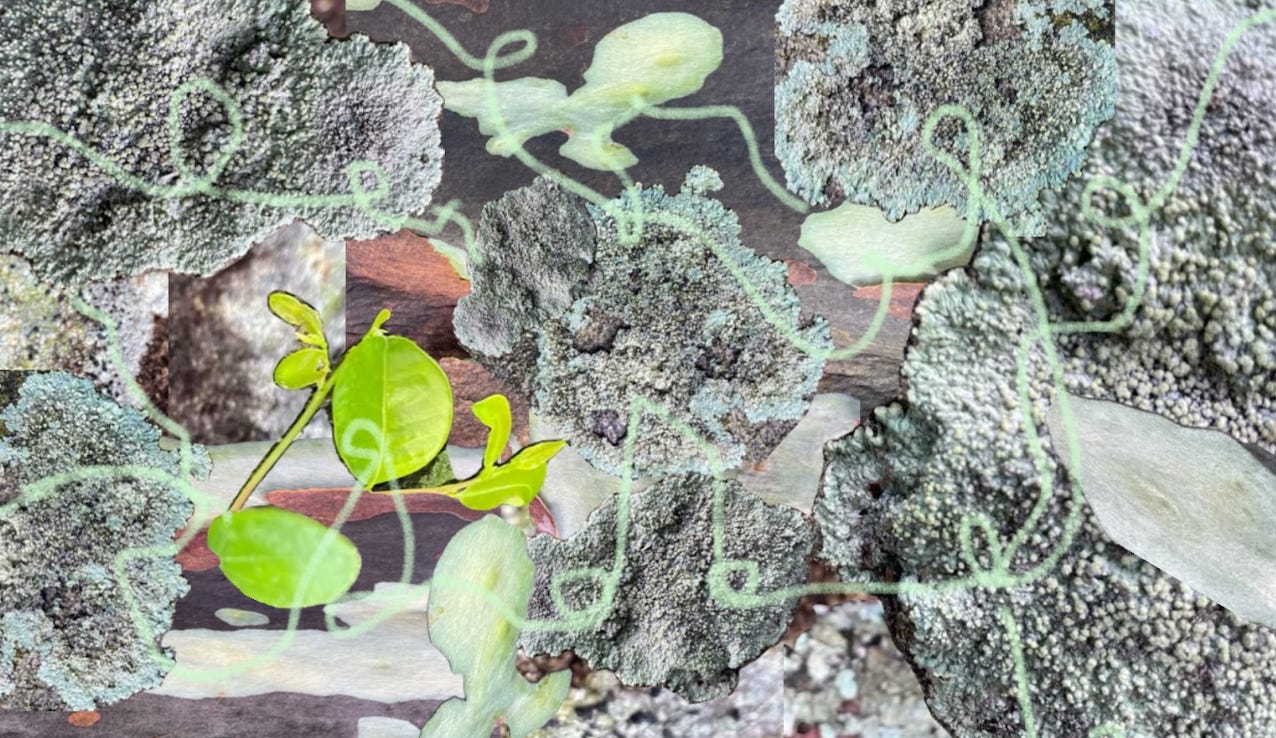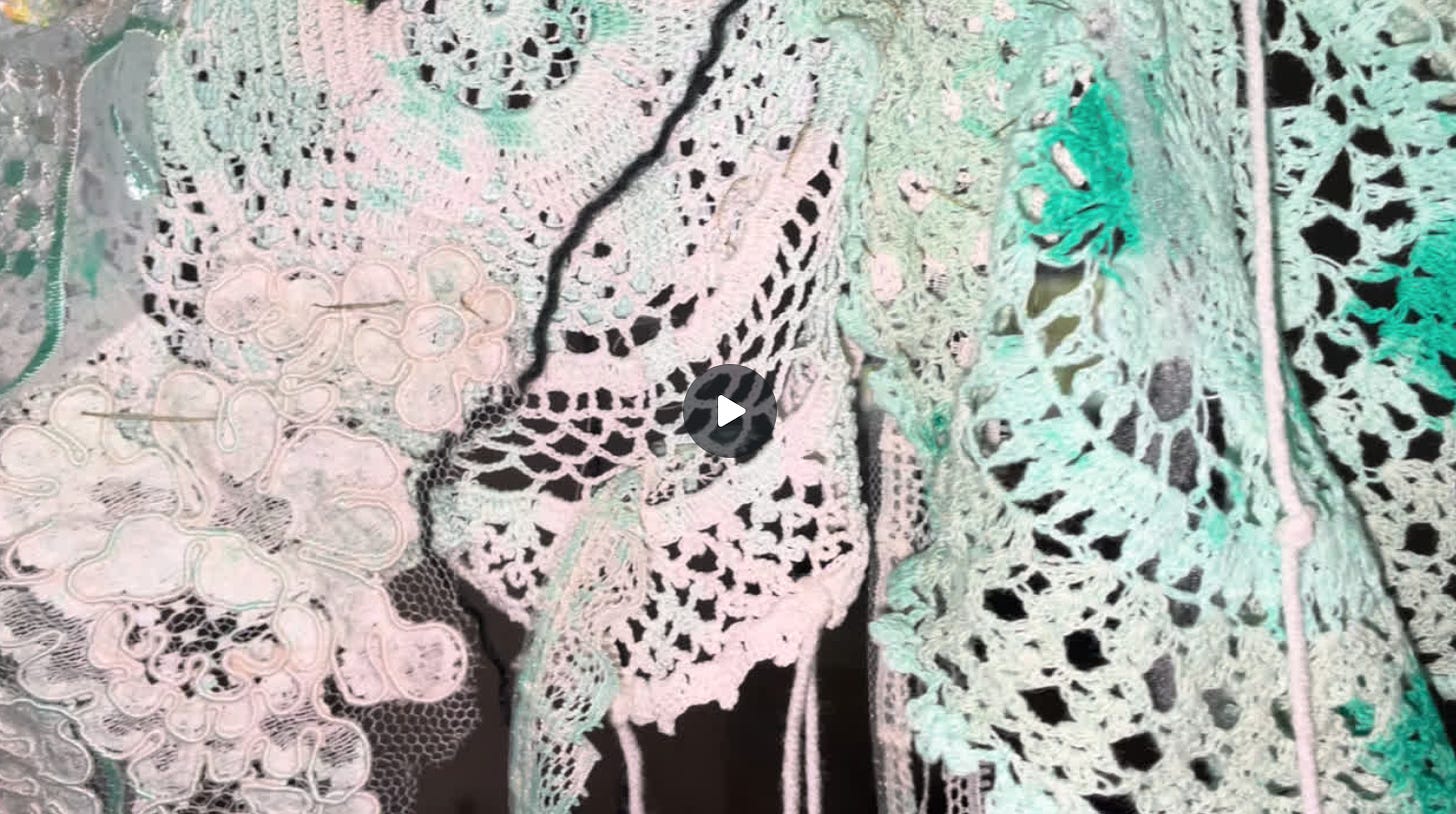Ecologies of Awe In Therapeutic Arts
How therapeutic creative practice works as a reflective inquiry of self.
☆THE DREAMER☆ is a free newsletter and online space for those dreaming at the intersection of creativity, therapeutic arts, ecology, magic, and neurodiversity. If you enjoy The Dreamer, support me by sharing it with your friends and social networks. And you can work with me in the following ways:
~ Book a tarot reading for Dec/Jan!
~ Purchase my books/decks.
~ Join my self-paced course, Write About Now.
~ Learn about 1:1 creative facilitation on a call with me.
~ Shop my vintage via @jericoroadvintage.
I consider myself an arts-based researcher as well as facilitator. That is, I make things as an inevitably-therapeutic form of inquiring into my own experience of being alive. I do this as an arts therapy post-grad student with a love of non-traditional academia, and incidentally, as a person engaging with the world around me. We all do, or could, if we allow ourselves.
I’ve learned a lot about myself through this process. And anyone can do it. It simply involves making stuff in a mindful, moment to moment state of expression, using a descriptive attitude. That is, not taking anything for granted or labelling something as it’s being made. If you’re capable of practising letting go of assumptions, being with what’s in front of you, and noticing your felt sensations, you're capable of playing in this way.
This is the way I work with people, increasingly. And in the interest of demystifying the therapeutic arts a little—and getting out of my own comfort zone and into edgy transparency—I want to tell you a story. It’s about the process of therapeutic arts inquiry I recently went on—sometimes by myself, sometimes with a working companion—and what I validated about my feelings, experience, and values in just a few days.
In short, a network of separate but related personal meanings as to the rhizomatic, dynamic, and deeply relational nature of my life, the whole world around me, even the way arts inquiry itself functions.
One thing any honest artist or creative will tell you, is that engaging with a material, natural or man-made, when done with a phenomenological spirit (as opposed to a presupposing psychoanalytic lens—although that’s fun for other purposes) discloses a dialogue between maker, the made, and the making. Where each opening—each choice moment, each relational response to a thing noticed, each new blooming piece of personal content (a feeling, a current truth) within a process—connects to many others, revealing a complex, entangled arrangement of possibilities and potential meanings.
I’ve come to refer to this multifarious arrangement with the same term I heard from Joanna Macy and use a lot when speaking spiritually; the web of life. What Thich Nhat Hanh means when he uses the term “inter-being” or what Atkinds & Snyder call ecopoesis; the “human creative process as part of, and embedded within, the ongoing creative process of the living earth and the universe”. This is the eternally variable, hyper-connected tapestry the Goddess we call awareness weaves from. Neith on her loom, Anansi on her web. It’s the observable nature of consciousness, no matter what language you put to it.
Creativity lives under the same rules as everything else. Even thinking about creativity is the same. For me, art-based inquiry into my own experience mirrors the natural world and has given me more language and understanding of what I value. Values that Indigenous cultures around the world have been sharing since the first sunrise.
This piece is about just one recent instance of inquiring into my own living experience, and the data that emerged from the most simplistic ground; the choice to notice a colour. The colour green.
“Pull it out by the roots one day and then next, there it is, creeping in around the edges … When you go, your footprints will fill with grass. Moss shall cover your tombstone … green shall spread over all, in all its shades and hues. This verdigris will overtake your swords and your coins and your battlements and, try as you might, all you hold dear will succumb to it.” — The Lady, The Green Knight
Noticing Green
I had started this particular therapeutic arts-based inquiry with the intention to inquire into what felt comforting and supportive about the theme of “containment”. That is, the feeling of curling up, the sensation of being covered. I had already created some firm, dense artistic expressions such as a hard bowl-like structure, a tightly wrapped egg-shaped structure, and thick, black mark-making.
Settling down to consider this content, I felt my hands drawn again to thread, but this time, they dwelled on a roll of rough, organic twine, curious about its dryness. I let my hands play, creating loops with it on a journal page, and felt a sense of “edgy” delight as the loops continued to form. Sticking them to the page, I allowed myself to simply doodle around them, staying present to the somewhat uncomfortable sensation of looping lines. I picked up different markers and wrote down words that floated into my conscious awareness until the page was full.
Finished, I looked down and saw a map. A diverse terrain, as seen from above. I saw the tanglement of nerves that I felt criss-crossing my upper body, sending chronic pain signals without ceasing. I saw borders; empire’s urge to sever one territory from another and the pain that brings, especially right now. And I saw green. Just one line. I recalled the same green in earlier pieces made by two companions and myself a day or two prior.
When previously I saw the greens, I chose not to notice them. But in this moment, as I looked down at this landscape of content within process, I did. I reflexively gathered up this intuitive clustering of works, as a way to organise them and in doing so—in collecting them in front of me and remembering to breathe as I felt my heart beat increasing—a word emerged. The word “growth.” Through two days worth of multimodal expression and exchange, and through a conscious choice to attend to a small detail and notice a pattern within my process, I was able to turn my attention to something gently emergent. And up sprouted a whole new field of content.
“Gathering together is an opening.” — John McHugh
Exploring Echoes
Emboldened by my choice to notice the recurrence of green, I jumped into the co-inquiry space with my next companion with a sense of openness that felt new. We came to discuss the mutual feeling we had in our inquiry of patterns being mirrored. Echoed.
Together, we chose to embody and amplify this sense of an “echo” of the macro-micro—of the life and experience of the inquirer and the inquiry itself—through vocal improvisation. As we began to echo each other. There were silly moments, we enacted sad moments, there was a chorus of noise when our dogs joined in, and as the process wore on, there were more and more moments of calm and spacious humming together. By the end of 45 minutes, the two of us had naturally fallen into a space of mutual, almost meditative silent drawing; an intuitive reduction of our vocalising.
When I consciously observed my drawing at the end, I felt the echo of our earlier conversation. The pen lines in my expression were a spiralling doodled network of green, growing outward in all directions. Now, I saw networks of mycelium, sending nutrients to the organisms around them, just as the winding, often spirallic, mesh of data in a therapeutic arts-based inquiry sends us knowings about our own experience through every mode, material, and form. I saw the echoes of expressions and the lived experiences and contexts they articulate, and the aliveness of relationality as a key nutriment needed to blossom the potentialities of meaning and even values within an inquiry.
“As parts self-organize … capacities emerge that could never have been predicted and that the individual parts did not possess. The weaving of new connections brings new responses and new possibilities into play.” — Joanna Macy
Clusters of Growth
I take out all my recent makings, bigs and small, displaying them all in front of me. From keywords I’ve noticed, works I’ve made, to journaling and scribbles I’ve done. After assigning them each a number from one to four, I select a random cluster. Number four. I notice how present the ecological world is, yet again. There are flowers here, patterns, and the words “aliveness” and “animism” among others.
I breathe into the current pain in my body. I feel my eyes, dry and sore from crying in front of my phone screen earlier. My whole body wants containment, even now. But the memory of vocal improvisation is alive here too. My body wants to be felt and heard. I take a few minutes to look at the multiplicity in front of me. And make the choice to title it “Growth”.
To create a new artefact, something that expresses “growth” now, I feel my hands drawn to a doily, echoing a fine, web-like structure with infinite connection points. Almost like an open circuit. I place it in water I’ve dropped green ink into. The ink rises in the middle of the fabric and spreads out through all sides towards the edges, blooming like mould, or bacteria, or a virus. This form feels uncomfortable to me. I try to imagine my attention melting out of my brain and down my arms, into my hands. Stay with it. I dab the cold green ink onto another doily and a scrap of lace. I loosely sew the three pieces together, letting the threads be crude and visible. Bacteria is growth too.
I contemplate this. Viral entities—both biological ones that enter the body and the viral images and ideas the internet presents us—spread via our conscious engagement and active sharing. They too are alive and part of the ecological world. Death is vital to growth. Decay is needed for renewal. Viruses are innate to life. At the height of the COVID 19 pandemic, many of us found new social connections, facilitated by online meetings, and new means of creative expression. So much life sprung from, was composted by, such suffering. McNiff says that even “chaos is purposeful in its groping … for a new and complex sense of order”.
“In fallen states, hills and streams are still there.” — Liu
Illuminating A Terrain
Now, I take myself for a slow and mindful walk down my own street. It had just been raining. I was immediately struck by all the green and its vibrancy. Lichen grew on top of bricks, like content emerging from the therapeutic arts process. I bent down and peered at their terrain from above, softly rubbing the canopy of these tiny forests; these ancient life forms that cling to and spring from other life forms, like personal data from one’s process and materials.
I notice too, how green the trunk of a tree looks, the colour peaking through between bits of fallen bark, scrubbed off from the rain. Patterns of meaning don't just spring from, but are also found under, the structures an arts process. Here, rain had called forth colour and new life. Likewise, our relational presence with arts materials and other people, calls forth, reveals, and shapes content and meaning.
I came home and made a quick collage. Trying to unravel our content from our curious, playful inquiry process is like peeling back layers to reveal more layers. There is necessarily no beginning to one and ending of another. Rather, content and process are in a shifting, dynamic, dance of exchange where one can't move forward without the other. They are connected systems of knowing too; alive, collaborative, and evolving as we do.
“Nothing can exist by itself alone. It has to depend on every other thing. That is called inter-being … A flower, like everything else, is made entirely of non-flower elements. The whole cosmos has come together in order to help the flower manifest itself. The flower is full of everything except one thing: a separate self, a separate identity.” — Thich Nhat Hanh
Web Of Life
I wanted to amplify something of the web of life I’m coming to know. This term for the natural world and even the online world I’m engaged with. In considering the wood wide web; that subterranean network of microbes connecting trees and distributing information and nutrients—I’m struck by the way arts-based inquiry too, sings of this same interconnectedness. And I’m beginning to wonder how separate the online individual and collective experience of generating and propagating data and shared insight really is.
Perhaps the field of reciprocal relations that is the web of life is inescapable and entirely non-dual by nature. Perhaps the internet is as natural a creation as an old growth forest, in that we (animals with the gift of awareness) made it in our own image. Perhaps separation, difference, borders, and boundaries, are simply a fiction that the process of relationality—even if it’s just between us and our rudimentary bedroom art supplies—allows us to trouble.
I add more splashes of green ink to more doilies, adding more hues. I soak others in the same green ink. I messily sew these mandala-like pieces of fabric together with green thread, letting the needle enter and exit the fabric at any point that it feels called to. I reflexively return to the wool I wrapped and wound so tightly into a hard egg structure. Holding it, I’m reminded again of the threads of nerves running painfully through my body. I breathe and tie them loosely onto the web. You too are a part.
I add additional material elements representative of my whole inquiry. The structure feels wet and heavy in my hands. I delicately tie its strings to the poles on my wall now. I look at it. I ask it what it needs; sound. I take my karaoke microphone and make some sounds, letting my body’s living internal systems speak of the ecologies of awe I’m becoming familiar with. I put it to video. It feels representative of the meaning I've made in these few short days: that life, like arts-based therapeutic inquiry, is dynamic, decentered, unfolding, and growing infinitely into new, liberatory possibilities of meaning, values, and action.
I am a body: a living landscape of experience, made up of, and overlapping with, the bodies and living experiences of every material, process, idea, and entity (human or otherwise, known or not yet known) that I'm tethered to. There is no end to the inquiry. Our lives are a web, a spiral, a circuit board of relationality.
But even more than that, I have come to remember that ecosystems are founded on connectivity and co-evolution. And nothing exists, or can be created, outside of these living systems. True embodiment of this knowledge is not a cerebral or solitary therapeutic endeavour, it is the recognition of an essentially interconnected, variable, ecological process by nature. All is entangled, linked, and bound in repeating loops and cycles. We shape our reality—we shape the world—together.
In just a few days, I walk away with not just more information about myself and my ways of knowing, or what I value, I walk away with a sense of what I’m going to do with this. A sense of being compelled to continue inquiring into earth-based therapeutic practices as an arts therapy student, as well as ways that the virtual or digital realm can be utilised as a tool of both therapeutic expression as well as ecological consciousness-raising and collective political change. McNiff says “we can make a new life, and we can do it best together, arguably most effectively and naturally in difficult times”.
This is the power of a therapeutic arts practice. Formally, as in the relational facilitation space, and informally, as a solo inquirer. I hope this story gave you a taste of what new self-data each of us is able to generate when we let go of notions of “good”, of perfectionism, and move towards to generative space of the unfamiliar, curious, playful, and even uncomfortable.
<3
If you’re curious about working in this way, with me as a guide—a therapeutic arts facilitator via online group in 2024—reply to me!
This is a daydream of mine that I’d like some relational accountability around. I’m also considering adding a paid tier/s on Substack next year specifically around offering organised arts and spiritual/wellbeing practices, prompts, and rituals. Let me know if you prefer one over the other.
xo Jerico





